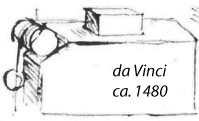Intro to Tribology
Origins of 'Tribology'
In Nature and Engineering
Historical Aspects
Broad Impacts
Tribology
Tribology is the science and technology of interacting surfaces in relative motion and the related matters including friction, wear and lubrication.
Historical Aspects
Although the term ‘tribology’ is less than half a century old and unfamiliar to most engineers, the field is one of the oldest in science. Lubrication practices and friction management date back thousands of years to the ancient Egyptians who documented the use of lubricated sledges to move a large statue. Leonardo da Vinci recognized the importance of friction, lubrication and wear, and subsequently conducted the first systematic tribology studies to support his machine designs.
Da Vinci first (although informally) noted the two basic laws of friction in the late 1400's. Amontons rediscovered these laws 200 years later and in the late 1700's, Coulomb formalized the second law, stating that the strength of the friction is proportional to the compressive force. Bowden and Tabor provided the first fundamental insight into these empirical 'laws' by demonstrating the relationship between normal force and 'real' area of contact. Modern instruments are accelerating our progress toward the next great fundamental breakthroughs in the field.


